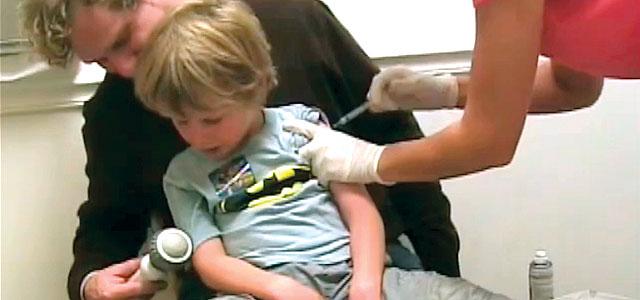
Commentary: Reducing Immunization Distress in Children Can Be Shot in Arm for Public Health
It is common to make light of people’s fear of needles, but from a public health perspective, needle phobia is no laughing matter. Present in at least 10 percent to 15 percent of the general population, needle phobia can undermine immunization efforts, which provide the most effective individual and large-group protection against devastating infectious diseases. Moreover, fear of needles also brings emotional pain and practical problems. People who fear injections and blood draws not only avoid immunizations, but also may experience extreme difficulty dealing with dental work, medical care, job applications and a host of other situations in which needle penetration is required.
Today in the US, most children experience about 25 needle immunizations during the first six years of life. Because of this, most children will experience some anticipatory anxiety by the time they are due for routine kindergarten vaccinations, and some children will experience extreme fear and distress.
Yet there are positive steps that health professionals and parents can take during childhood to reduce the fear, anxiety and dislike of immunization injections so that these feelings need not be long lasting or permanent. We have developed and refined a novel, multifaceted and evidence-based distraction technique that captures and uses the child’s imagination during immunization injections to change what was once a fear-inducing procedure into an engaging, even comforting experience for child, parent and health care workers alike.
To be clear, distraction does not mean tricking the child. Instead, as the embedded video shows, our method engages the child’s curiosity and wish for reduced pain in a sequence that relies on keeping the child informed and empowered, while rendering the steps through multiple injections predictable and truthful. Those administering the injection work from a script derived from the language of hypnotic suggestion that draws the child into the process. The distraction element is built into a game that takes attention away from the injection and focuses it elsewhere. A willing and prepared parent or caregiver can participate in the game portion of the technique, which adds a sense of acceptance and familiarity to the whole process.
In two randomized clinical trials, we have shown that this method is highly effective. Its adoption – as well as the incorporation of additional evidence-based measures to reduce immunization pain – can do much to alleviate children’s and adults’ fear of injections. Proactive measures such as these can make an important contribution to public health disease prevention efforts, while also promoting the long-term health and medical visit comfort of individual children and their families.
F. Ralph Berberich, who developed the method described above, is a physician who has spent over 30 years in clinical pediatric practice. He is a founding partner of the Pediatric Medical Group in Berkeley, California, now affiliated with the Sutter East Bay Medical Foundation, and is on staff at Children’s Hospital Oakland and the Alta Bates Summit Medical Center, where he previously served as chairman of the department of pediatrics. He is a member of both the American Academy of Pediatrics and the American Society of Clinical Hypnosis and co-author of The Available Pediatrician.
Linda Sturla Franck collaborated with Dr. Berberich to introduce parent participation into the technique described above. She is chair of the Department of Family Health Care Nursing at UC San Francisco School of Nursing, with a program of research that focuses on health care for acutely and chronically ill infants and children, in primary, secondary and tertiary care settings, with a particular emphasis on pain assessment and management. This includes research on the assessment and management of the side effects of analgesia and sedation, as well as investigation of the long-term consequences of pain and pain treatments on the developing child and family.



